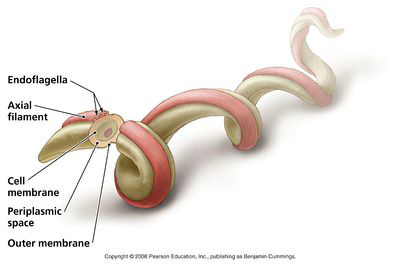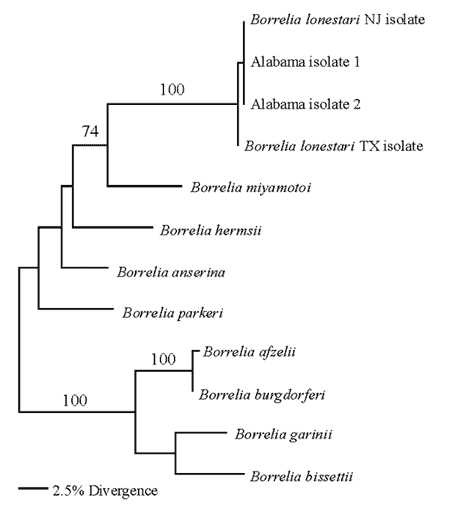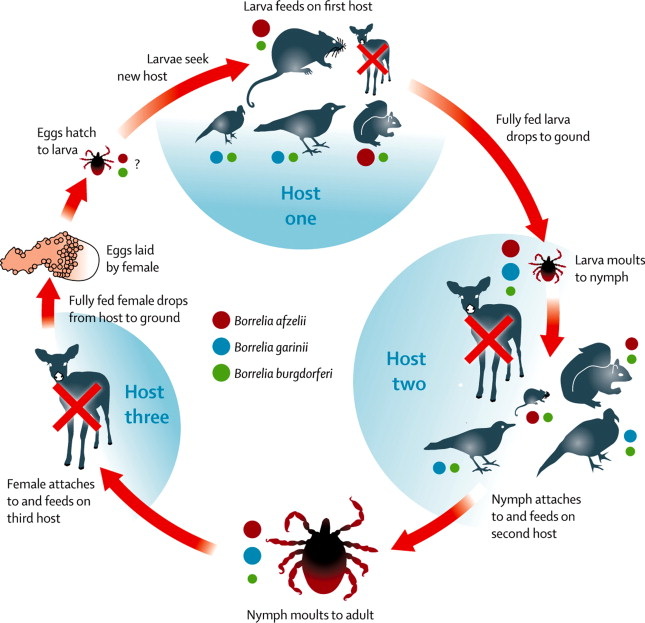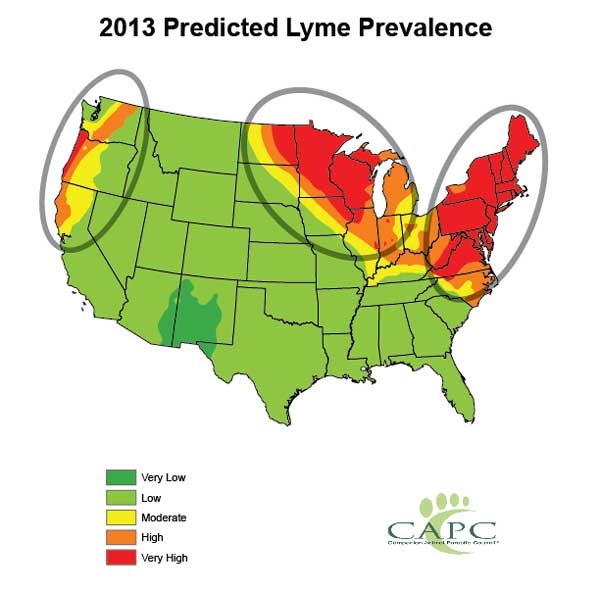 pic (21)
pic (21)
Classification:
- Diderm, helically coiled bacteria that move in a corkscrew using endoflagella (4)
- Corkscrew motion is thought to be an adaptation to its viscous environment (6)
- There are 3 strains; collectively referred to as B. burgdorferi sensulato (4)
- Longer than they are wide (length 20-30 um, width .2-.3 um wide) (4)
- Must be viewed with dark field microscopy (uses special condenser that directs light toward an object at an angle, rather than from the bottom; particles or cells are seen as light objects against a dark background) (6)
Maximum parsimony phylogenetic tree generated by using PAUP. Numbers indicate parsimony bootstrap scores for the branch. Only bootstrap scores >70 are included in the phylogenetic tree.
Natural History:
Reproduction:
- Requires a host to reproduce; though it can reproduce whenever as needed no matter the surroundings (within host) while also evading the host's immune system (5)
- Reproduces by binary fission (4)
- DNA is arranged along the inside of the inner membrane (4)
- Division time is 12-24 hours (4)
- Can remain in the human body for years in a non-metabolic state; antibiotics can't detect it because it's not metabolizing (5)
Habitat/Pathogenicity
- Most prevalently found in the north-eastern United States (23)
- Invades the blood and tissues of various infected mammals and birds (6)
- Screws into the cells and causes them to release digestive enzymes to dissolve themselves (4)
- Alters the proteins expressed on its outer surface depending on the state of each host (7)
- The natural reservoir for the bacteria is thought to be the white footed mouse (6)
- Ticks transfer the spirochetes to the whitetail deer, humans, and other warm-blooded mammals (4)
- In humans, dogs and many other animals, infection results in Lyme disease (4)
- Mimics the symptoms of Fibromyalgia, Chronic Fatigue Syndrome and MS (4)
- Diseases caused by spirochetes are relapsing, difficult to detect and great imitators of other diseases (4)
Conservation Status:
- Since its discovery, cases have dramatically increased; the disease has become an important public health problem in some areas of the U.S. (6)
Interesting Facts:
- Attacks B-lymphocytes in humans; some strains can strip the cell membrane of the B-lymphocytes and wear it as a cloak (4)
- Lyme disease can present mildly to some and be devastating to others (4)
Summary of Research Article (26):
The research paper Persistence of Borrelia burgdorferi in Rhesus Macaques following Antibiotic Treatment of Disseminated Infection sought to determine how well antibiotics worked to eradicate the B. burgdorferi bacteria using nonhuman primates. In this study, Rhesus macaques were infected with Borrelia burgdorferi. After 4-6 months, the experimental group was treated with antibiotics to determine if the bacterial infection persisted even after treatment. Tests were conducted to detect residual organisms after the antibiotic treatment. They included: the feeding of lab-reared ticks on monkeys (xenodiagnosis), culture, immunofluorescence and PCR. Antibody responses to the B. burgdorferi-specific C6 diagnostic peptide were measured longitudinally and declined in all treated animals. These tests revealed that B. burgdorferi antigen, DNA, and RNA still resided in the tissues of animals after treated with antibiotics. Even small numbers of intact spirochetes were recovered by xenodiagnosis from treated monkeys. This result was interesting because when B. burgdorferi is studied in vitro versus post-dissemination in a primate host, antibiotics are effective at killing it. The finding that B. burgdorferi persists in the host even after antibiotic treatment needs further research regarding the pathogenicity of antibiotic-tolerant persisters and their contributions to post-treatment symptoms.
The research paper Persistence of Borrelia burgdorferi in Rhesus Macaques following Antibiotic Treatment of Disseminated Infection sought to determine how well antibiotics worked to eradicate the B. burgdorferi bacteria using nonhuman primates. In this study, Rhesus macaques were infected with Borrelia burgdorferi. After 4-6 months, the experimental group was treated with antibiotics to determine if the bacterial infection persisted even after treatment. Tests were conducted to detect residual organisms after the antibiotic treatment. They included: the feeding of lab-reared ticks on monkeys (xenodiagnosis), culture, immunofluorescence and PCR. Antibody responses to the B. burgdorferi-specific C6 diagnostic peptide were measured longitudinally and declined in all treated animals. These tests revealed that B. burgdorferi antigen, DNA, and RNA still resided in the tissues of animals after treated with antibiotics. Even small numbers of intact spirochetes were recovered by xenodiagnosis from treated monkeys. This result was interesting because when B. burgdorferi is studied in vitro versus post-dissemination in a primate host, antibiotics are effective at killing it. The finding that B. burgdorferi persists in the host even after antibiotic treatment needs further research regarding the pathogenicity of antibiotic-tolerant persisters and their contributions to post-treatment symptoms.



